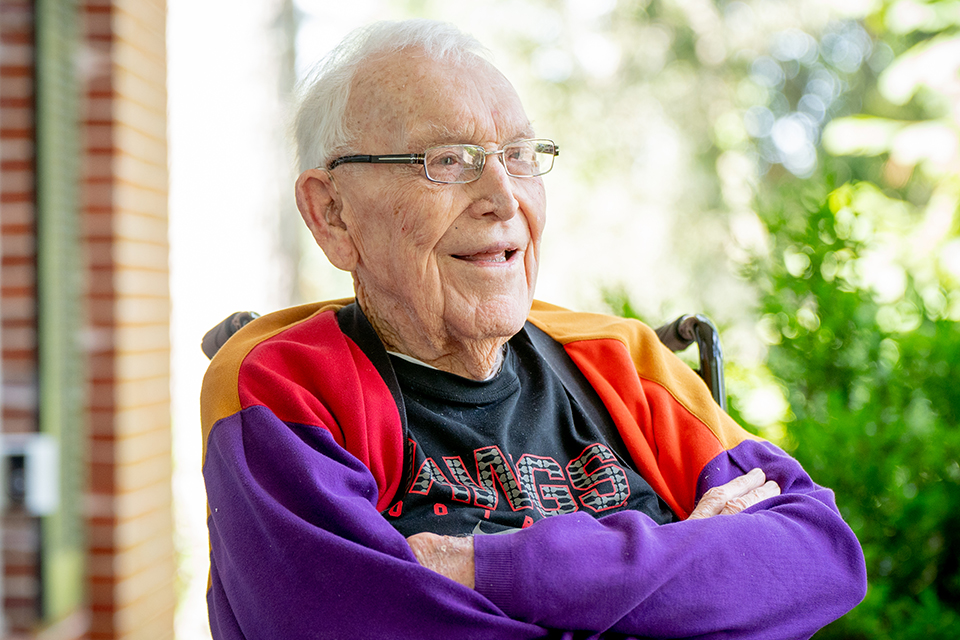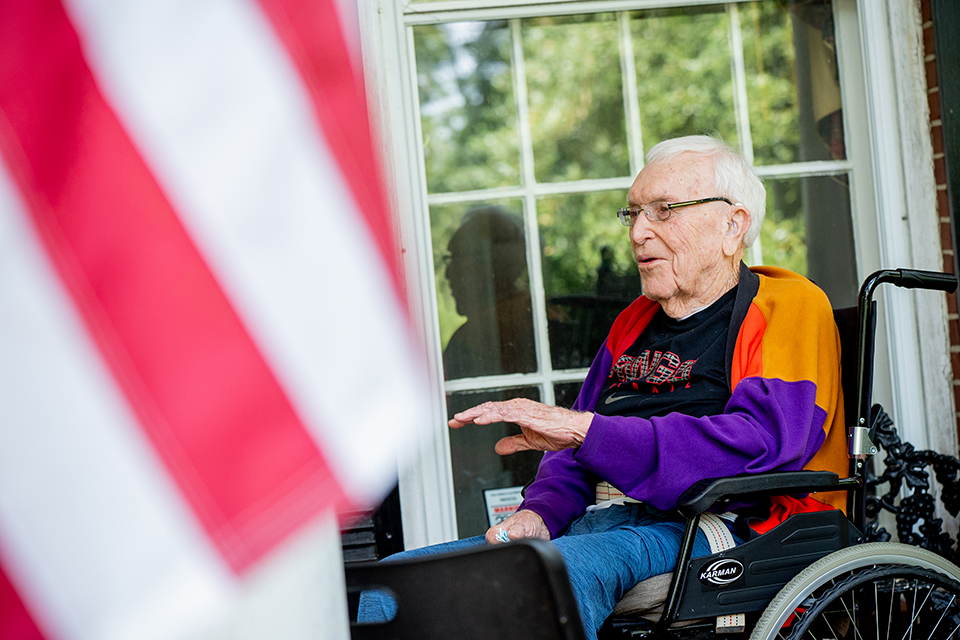After dark on the day he turned 22 years of age, Harold Storey (BBA ’42) bedded down with a few buddies in the basement of a French house near the Moselle River.
They had a birthday blast. Literally.
German artillery fire blew away the entire structure over their heads.
That was Sept. 21, 1944. Storey arrived in France on July 9, soon after the Allied assault on D-Day.
After wading ashore at Utah Beach, Lt. Storey had for the next 74 days led the men of C Company, 10th Infantry, Fifth Division — soon to be part of George S. Patton’s famous Third Army — in a constant running battle with Hitler’s retreating forces.
Fast-moving Allied forces flipped the script on a German military machine that gave blitzkrieg (lightning war) to the world. (In 1940, Germany overran France and the Low Countries in just six weeks.) Now Allied tanks and infantry were returning the favor, systematically liberating one town after another from Nazi occupiers: Saint-Lô. Chartres. Marne. Verdun. And Metz.
In Metz on Sept. 11, still just 21 years of age, Lt. Storey earned a Silver Star Medal, the United States military’s third-highest decoration for gallantry in combat … though he didn’t yet know it.
Lt. Storey and his men secured a key Metz bridge over the Moselle River, braving German fire in a headlong charge with fixed bayonets and war whoops. The lieutenant then directed C Company to a hilltop that strategically commanded Metz and its new bridgehead. He skillfully deployed 43 soldiers, all that remained of an original 165 after days of battle, along a gap in the defenses that looked vulnerable to the young man from the hills of north Georgia.
The Germans saw the gap too, and they knew the ground — Hill 386 was used to train German soldiers. If Hitler’s troops could counter-attack, split the Allied forces, and reclaim the bridge over the Moselle, they might stop the relentless advance.
The Germans attacked. They came in waves. They came for five straight nights.
Lt. Storey and his desperate GIs fought them off again and again with just two .30-caliber machine guns, one bazooka, and their rifles. Between assaults, German artillery shells rained down.
The beleaguered GIs held Hill 386 for nearly a week. At last, the Germans backed off. Pilots of Allied P-47 Thunderbolt fighter planes that lent air support in daylight estimated that 500 German soldiers lay dead on the slopes in front of Lt. Storey’s position.
The baby-faced Georgian ought never to have led that mountaintop defense. The morning he arrived at the Moselle River Lt. Storey was fifth in chain of command. By that night, he was the senior officer — all four of his superiors were killed or disabled.
Later, as his unit got some badly needed rest, a battalion executive officer told Lt. Storey he’d been awarded a Silver Star.
What for? the lieutenant asked, bewildered. I was just doing my job.
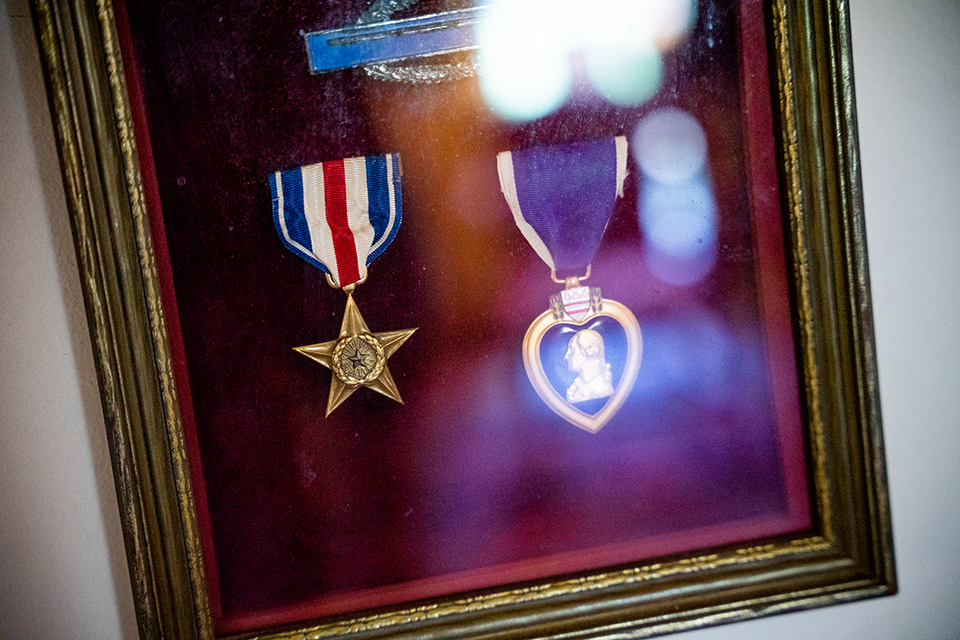
An American tale
The story of Harold Storey, now age 99 and revered as one of the most distinguished citizens in Rome, mirrors the story of 20th century America.
He was born into a rural world, like most Americans of 1922 . His family ran a local sawmill and other operations valuable to farmers and self-sufficient mountain families that commonly lived without running water, electricity and other modern comforts.
Storey came of age in the Great Depression. “Not everybody could afford to buy gasoline,” he remembers, “so some of the farmers took the tires off their automobile and put them on their wagons.” He worked side-by-side with the grown-ups at countless labors of country life — building barns and house additions, hoeing vegetables, cutting lumber, tending cows and lugging milk to the spring to keep it cool, then hauling buckets of fresh water back to the house.
Things have changed.
Storey sits on his front porch today, peering out at his green suburban neighborhood across the Oostanaula River not far from downtown Rome. An American flag lolls in a morning breeze. Time has diminished Storey physically, and he needs a wheelchair. His mind, though, is still as bright as an August morning, and his expressive face seems overlarge, imposingly noble, like a Roman bust.
Storey built the family house in 1953 before Rena, his daughter, was born to him and another Rena, his lovely wife. (A son, Hal, came along in 1957.) Storey took out three mortgages on his white-columned brick home, paying by the month for decades until those installments finally violated his business sense. In the 1990s, he wrote a good-riddance final check to end the aggravating monthly mortgage payments.
He’d been shelling out the cursed sum of $104 a month.
Even during the Depression, Storey says there was never any doubt he’d go to college, never any doubt where he’d go, and never any doubt what he’d study.
“I wanted to be something big,” Storey confesses. “I decided I would rather live as a graduate of Terry College and the University of Georgia than do anything else, anywhere else.”
Why business?
“I didn’t know there was anything else to do,” he says. “For my sense of self-worth, I had to be a good business person. I was concerned about my image as a family man.”
The drums of war beat steadily as Storey arrived on UGA’s campus on his birthday in 1939. Rumors of war were constant background noise as Storey enjoyed business classes, Alpha Tau Omega fraternity life, the Demosthenian Literary Society, Strahan House, and other attractions of university life. The youngster signed up for ROTC so he’d qualify to be an officer if war broke out.
That happened soon enough.
“A fraternity brother came running outside one Sunday yelling about an attack on Pearl Harbor,” Storey says. “I wasn’t the only one who had to look around to find out where Pearl Harbor was.”
Uncle Sam needed soldiers now, and ROTC units found themselves fast-tracked toward graduation. Storey took his Terry College BBA with a specialty in accounting early, in December 1942. He received orders to report to Officer Candidate School at Fort Benning, and in the blink of an eye was training to lead men in battle. He practiced soldiering in Indiana, South Carolina, Tennessee and New York.
To transport troops to the European Theater the U.S. military mobilized almost anything that floated. Storey made his maiden voyage across the Atlantic on a banana boat.
“We were so cramped,” Storey remembers, “that the four men in each cabin only had room between bunks to stand a suitcase on end for card games.”
Lt. Storey goes to war
He entered a dangerous world where events were shaped in faraway rooms — board rooms, war rooms, smoke-filled political rooms — but a world where every individual act might have consequences.
Storey’s son-in-law Bill Henderson describes that time perfectly in a very readable 2020 memoir, A Man of Peace Goes to War, written by Harold Storey with the help of a bright young neighbor, actor James Arthur Douglas, and Dekie Hicks.
“We see with Harold Storey,” Henderson writes, “the unusually personal and seemingly insignificant daily decisions that one Georgia boy had to make without any more preparation than a good heart, a trusty sense of love and duty, and an ability to see what had to be done and the courage to do it.”
Lt. Storey spent most of his tour de France on foot. He and his command marched east, town by town, hill by hill, through the fall of 1944, driving deeper and deeper toward Germany as the bitter winter of that year descended.
Then, on Jan. 22, 1945, the war ended for Harold Storey.
A ferocious German counterattack caved in a huge section of the Allied front — an assault known as the Battle of the Bulge. Lt. Storey once again led brave men in desperate defense of a position, only this time in snow and freezing temperatures.
That day, an artillery shell struck a tree limb over Lt. Storey’s head. The explosion instantly killed a man on either side of the lieutenant, and it almost killed the young Georgian too. Jagged shrapnel tore through Lt. Storey’s neck between his windpipe and jugular vein, and metal shards pierced his body.
Lt. Storey’s comrades got him out to an improvised local hospital. After medics got him stabilized, Lt. Storey shipped off to hospitals in Luxembourg and France on his way to a less-tumultuous convalescence in Salisbury, England. In all, he spent four months in hospital rooms recovering from the life-threatening wounds.
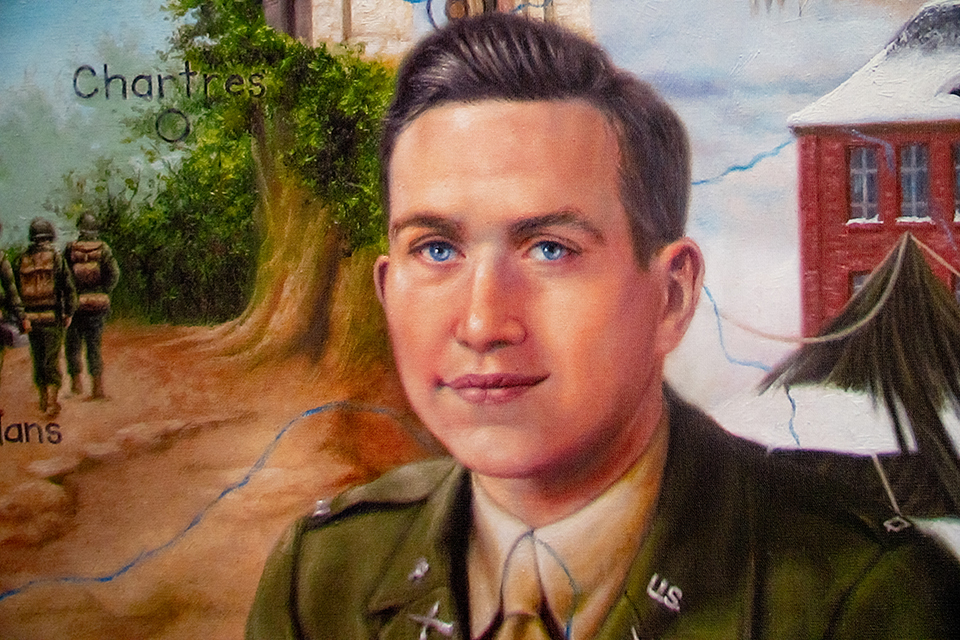
Trade School challenge
When Lt. Storey at last was well enough to step out into the English springtime, he found a challenge that put his Terry College business skills to a remarkable test.
A U.S. colonel dropped by with an assignment. The mission? Set up a technical school for GIs stationed in Europe who were idly waiting to return home. Many bore wounds, like Storey. Learning various trades as they waited would give them a better chance to reenter everyday life and make a living back in the states.
In Freckleton, a scenic town on the Irish Sea, Storey launched the complex large-scale project at a former B-17 repair site.
“There were classes offered in almost any field, such as art, business, industry, etc.,” he tells in his memoir. “They had classes for painting, operation of cranes, automotive repair, and many other mostly technical studies … The instructors, who came from all over the United States, were very good leaders in their fields.”
Lt. Storey put all his ingenuity into creating, from scratch, a basic trade school. He led efforts to borrow hundreds of beds and mattresses from nearby Oxford University. He oversaw details as fine as the design and creation of special uniforms for instructors, who come over from Westinghouse, General Electric, and other major U.S. companies.
The school processed 4,000 students in each eight-week term, and it fell to Storey and his staff to house and feed and accommodate the restless GIs.
“It seemed to me like the most wonderful thing a guy could do,” Harold says, “to help a bunch of kids get back home.”
It turned out to be wonderfully healing work at another level.
“I’ve called it the ideal PTSD (post-traumatic stress disorder) experience,” Storey explains. “I had time to ease up and deal with the experiences of the war before going home. I had men around me I could talk to.”
Even so, Storey at age 99 still asks to keep a light on in his bedroom at night and even during naps. It comforts him to be able to see if he wakes up. He spent so many scared nights staring from a foxhole into darkness, knowing a deadly enemy lurked out there, unseen.
It’s a wonderful life
In 1945, Harold Storey came home. He met and married a beautiful young woman. They had beautiful children, then grandchildren, as they settled into a more predictable life in north Georgia. Harold and Rena, a professionally trained painter of museum-quality portraits including a notable sitting of her husband, recently celebrated their 71st wedding anniversary.
Rena found a good man.
“Harold is a social being who is sensitive, resourceful, gregarious, of strong opinion, and fearless at times,” she says in her husband’s memoir. “He wants to change the world for the better. World War II was a defining and transforming experience in Harold’s life. With death occurring all around him, life took on a very different meaning.”
She adds, “When we were dating, his values and morality all resonated with me. Faith is very much a part of who Harold is.”
The returning warrior went into business with his father at the S.I. Storey Lumber Co. (Storey’s brother, Bernard, came on board after his own military service in the Pacific.) The Terry skills helped again — business boomed in a nation booming after a war that left the U.S. standing unrivaled on the world stage.
People who knew Storey saw him, every time he faced a decision, make the kind choice. It characterized his involvement in more than 30 different business, civic, and school organizations through the post-war years.
Storey shared the views of John Lewis, the Civil Rights champion who served Georgia for 17 terms in the U.S. House of Representatives. Storey says, “I always wanted, like the congressman, to look out for the down-and-outers.”
Is there a Silver Star for good citizenship? Storey would surely wear one.
He led one campaign after another in civic affairs in Rome — point man in efforts to create the Rome Symphony Guild, guiding hand in building the city library, champion of a men’s homeless shelter and a substance recovery facility. He served on boards or played major roles in support for local theater, the Red Cross, the YMCA, Kiwanis, and dozens more organizations. He sat on the advisory board when Berry College, near Rome, created its business administration graduate program.
Anyone who planted trees in the state of Georgia knows Harold Storey — he directed the Georgia Forestry Commission for eight years. People around Rome who needed money knew Storey too, as a charter director and organizer for First Rome Bank and First Community Bancshares. He directed the Chamber of Commerce, which honored him with a lifelong membership.
At First Baptist Church in Rome, Storey taught Bible study for a quarter-century. And it was the Storeys who led the church in sponsoring four Kurdish families seeking refuge in the U.S. after displacement in a new war. Storey’s family says they collected a truckload of clothing to send to Kosovo during that conflict, and they gathered and shipped almost 1,000 pairs of used eyeglasses to the Middle East.
“I learned from the start of my life,” Storey explains, “how to love somebody that didn’t look like me.”
He’s done much, much more. In recognition, Rome’s Heart of the Community Foundation in 2000 bestowed its annual award on him. The town turned out to honor Storey at a black-tie affair, cheering for the lion of their community as wildly as the liberated French cheered welcoming American troops 66 years earlier.
“The Heart of the Community Award is designed to honor individuals who could be considered unsung heroes,” awards committee chair Andy Davis told the Rome News-Tribune. “Mr. Storey’s involvement and dedication to numerous organizations in the community exemplifies the spirit of this award.”
Storey’s 2oth century is America’s. Both evolved from rural roots, held true to values through the challenges of a Depression and war, reached prosperity, grew to prefer city life, and offered honorable generosity to others.
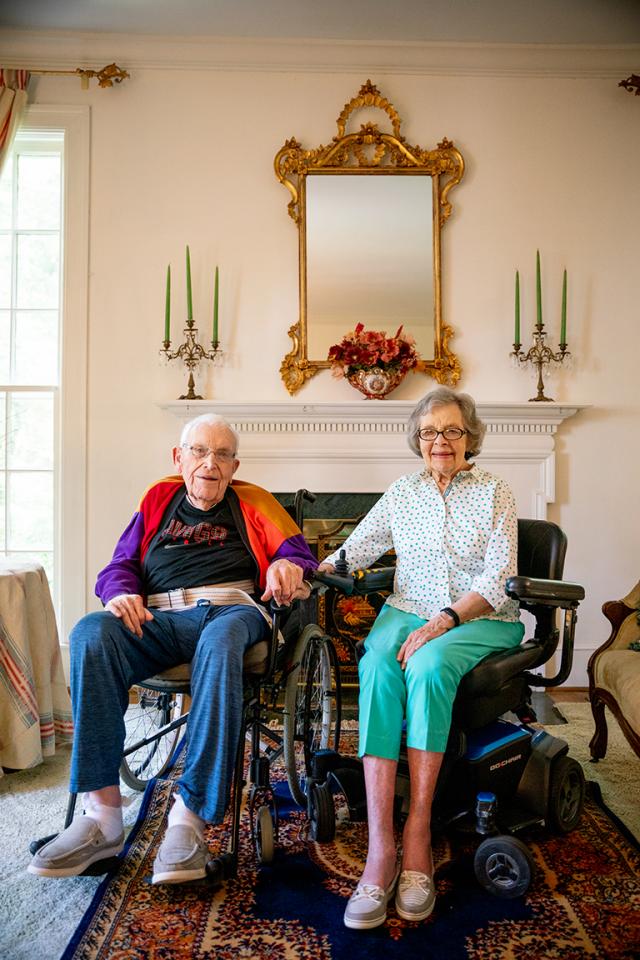
A moment of truth
One vivid wartime moment illustrates the authentic compassion of Harold Storey.
During the Battle of the Bulge, he and his company bypassed two wounded German soldiers, an officer, and an enlisted man. Under fire and at risk, the GIs hurried on to a safe site without stopping.
It was Christmas Day.
A replacement medic in Lt. Storey’s unit, Private First Class Robert W. Cassels Jr., a favorite of the company, begged Storey for permission to return to the wounded enemy soldiers and treat their wounds. Though he had misgivings, Lt. Storey said yes.
A long time passed. Darkness descended. The medic had not returned. Storey ventured out alone in search of PFC Cassels.
He found the amiable medic. Cassels had been shot through the helmet, likely by a German sniper. His lifeless arm still embraced one of the wounded Germans he’d been helping with the final act of his life.
“My emotions nearly tore me apart!” Storey confesses in his memoir. “Anger raged through me like never before. It was expected for me to shoot the squirming and begging German men laying on the ground. I cocked and raised my carbine and pointed it at the captain.”
Then Lt. Harold Storey, age 22, a young man baptized in a creek named for his family and respected for his devoutness among fraternity brothers at UGA, remembered his better angels.
“Immediately, images of my family ran through my head,” he wrote. “Today was Christmas Day. Somehow, I thought that if I did survive, I would never want to remember that I had killed two helpless people on Christmas. I would not want my family to know I had done such a thing. It was really mostly selfish, with some compassion thrown in. I also knew this would not be a fitting tribute to the short and beautiful life Cassels had lived.
“I didn’t pull the trigger.”
The greatest
Journalist Tom Brokaw recounted Storey’s remembrance of PFC Cassels in his 1998 bestseller The Greatest Generation.
Brokaw realized that World War II veterans were fading away, and he attempted to gather and preserve their stories while they could still tell them.
Before the COVID-19 pandemic, the Veterans Administration reported that the United States lost 245 World War II veterans each day to age and infirmity — a joyless casualty count. Of 16 million men and women who served in the U.S. Armed Forces in WWII, just 325,574 remained alive as of May 31, 2021.
Sitting with Harold Storey on a morning in August 2021, hearing his stories, watching the remarkable eyes that have seen nearly 100 years of history and some of the most terrible and most beautiful moments a life can offer, it’s easy to believe Brokaw.
The greatest generation.
So many owe so much — perhaps even freedom itself — to Storey and the soldiers still in line with him in these peaceful last miles of their long march.
Editor’s note: Mr. Storey passed away Nov. 21, 2021, in Rome, Ga. He was 99.
